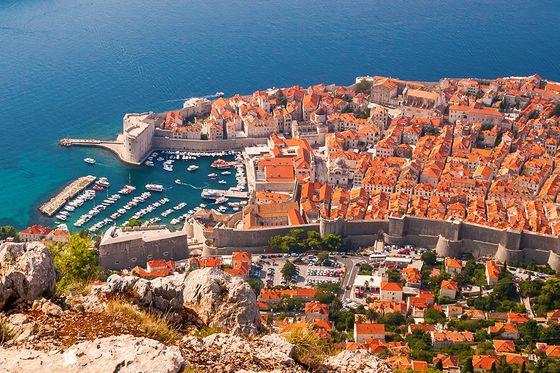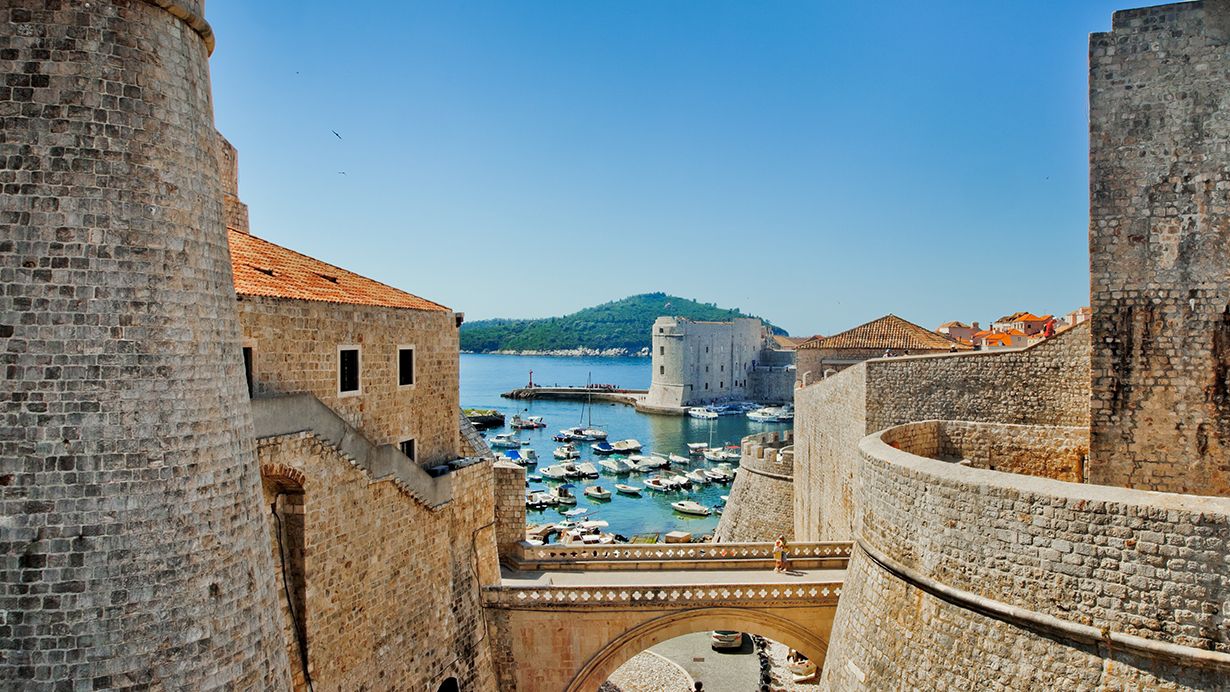
When is the best time to visit Croatia? Here’s your season-by-season guide
Croatia’s beauty stuns year-round, but which of the country’s seasons will deliver your perfect vacation? We’re covering Croatia’s climate, weather, and more, so you can plan with ease.
When is the best time to visit Croatia? Whenever you’re ready! Whether you’re chasing summer sun, celebrating the harvest, or cozying up for winter festivities, Croatia is ready to welcome you. Join us on one of our Croatia tours and see for yourself why there’s no bad time to visit this diverse, coastal country.
The best weather in Croatia by month
Croatia experiences four distinct seasons, but it can be challenging to determine the weather since it varies depending on your proximity to the coast. We recommend packing seasonally and accounting for at least a 10-degree variation between the warmer shores and cooler inland regions. If you want to make the most of your trip to Croatia, check out our recommendations for seasonal activities below.

Spring in Croatia
Months to experience Croatia in the spring
April and May
Go for lighter crowds and sweet-smelling flowers
There isn’t one best time of year to visit Croatia, but springtime holds a certain magic. The weather is pleasant, with mild temperatures and sunny afternoons interwoven with cool, coastal breezes. The anticipation of the busy summer season may hang in the air, but you’ll find fewer visitors at many of the best locations in Croatia—meaning you won’t have to fight through crowds in popular places like Split’s Diocletian’s Palace or Dubrovnik’s Old City.
“This trip has a little bit of everything the country offers,” said traveler Annalise after returning from our A Week in Croatia: Zagreb, Split & Dubrovnik tour. “It’s not too slow nor too fast-paced. We went in May, and it was perfect and just before the height of the summer tourism season. We had a great guide, bus driver, wonderful hotels, and excellent included dinners.”
What to do in Croatia during the spring
If you happen to visit Croatia around Easter, you’ll find the country blossoming with festivities. Larger cities, like Zagreb, will be adorned with colorful decorations and come alive with performances. Peruse handmade crafts and sweets in the city’s many markets, attend a religious ceremony, or sit down to eat a traditional meal of lamb or ham with sweet breads and cakes.
Since the crowds will be lighter, spring is also an ideal time to explore Croatia’s outdoor attractions, like the historical village of Kumrovec. This quaint town is an open-air museum featuring restored cottages and gardens that provide a glimpse into what rural life was like here more than a hundred years ago. Join us on the Kumrovec & Medieval Tabor with Dinner excursion on our A Week in Croatia: Zagreb, Split & Dubrovnik tour to see the landscape awash with spring flowers.
Weather in Croatia in April and May
Spring in Croatia is mild and refreshing. Along the Adriatic coast, temperatures range from 50–70 F, with plenty of sunshine and occasional showers. Inland areas, including Zagreb, are slightly cooler.
Experience Croatia’s springtime on these tours

Summer in Croatia
Months to experience Croatia in the summer
June, July, and August
Go for island-hopping and sun-drenched days
According to our Croatia Travel Guide, summer is the best time to visit Croatia for days of endless sunshine. The warm Mediterranean climate is ideal for beach vacations and coastal exploration. When you join us on one of our Croatia tours during the country’s peak season, you may have to contend with larger crowds, but it’s worth it for the salt-kissed summer breezes.
Take a tip from staffer Emily’s book and cool down with a frosty treat while you explore coastal spots in the summer. “Instead of getting a sit-down lunch in Zadar, I ordered gelato and enjoyed it while sitting on the steps of the Sea Organ,” she said. “Good food and seaside views. It’s the perfect combo!”
What to do in Croatia during the summer
Summer is hands-down the best time of year to visit Croatia if you’re dreaming of sun, sand, and the sapphire Adriatic Sea. Go beach-hopping on the Croatian coast or add the Korcula Island extension on our Greece, the Balkans & Croatia tour for an extra dose of salt air and seaside life. Warm summer nights are also the perfect time to get out on the water. We recommend taking the Scenic Dubrovnik Coast Cruise & Dinner excursion offered on our Croatia tours to see how the city stuns from the sea.
The warmest months are the best time to transport yourself to Westeros at Croatia’s many “Game of Thrones” filming locations as well. Sure, you can visit the UNESCO-listed Cathedral of St. James in Sibenik any time of year, but the summer heat really makes it feel like you’re walking up to the Iron Bank of Braavos. Head up the Baroque Staircase, which stood in for the steps leading to the Sept of Baelor, and make your way to Lovrijenac Fortress. (True Westerosis will recognize it as the Red Keep.)
Weather in Croatia in June, July, and August
Summers are hot and dry. Along the coast, temperatures hover between 75–90 F. Inland regions can get even hotter, sometimes exceeding 95 F.
Bask under Croatia’s summer sun on these tours

Fall in Croatia
Months to experience Croatia in the fall
September, October, and early November
Go for changing leaves and spectacular sunsets
If you’re planning a trip to Croatia, you should know that visiting the Adriatic Coast in the fall could be a life-changing experience. The weather is warm and mild, and the shorter days mean earlier sunsets, so you’ll have plenty of opportunities to admire them when you’re out and about. Plus, autumn’s your travel season if you want to spend some time in Croatia’s abundant countryside and spectacular national parks. Hiking around the terraced lakes of Plitvice Lakes National Park is always a pleasure, but it’s especially exhilarating when the weather is still warm and the foliage is ablaze with color.
“This was a fabulous trip,” said traveler Starr of our Croatia & Slovenia: The Old-World Adriatic tour. “The excursions were totally worth purchasing. Our group and local guides well met my expectations. Fall is definitely a time to go due to the beautiful fall colors—truly a bonus.”
What to do in Croatia during the fall
Autumn is Croatia’s grape harvesting season, and the whole country celebrates with an array of wine festivals. When you join us on our Croatia & Italy: Dubrovnik to Venice tour, you’ll have the option to add our Pula, Istria Wine Tasting & Dinner excursion. Istria celebrates the harvest with a Wine & Walk, which typically takes place in mid-October. Participants hike through the region’s vineyards with glasses of wine in hand, stopping along the way to sample more.
The fall harvest season is also a wonderful time to visit a Croatian agriturismo. When you join us on our Greece, the Balkans & Croatia tour or on the Konavle Wine Tasting & Lunch excursion offered on our A Week in Croatia: Zagreb, Split & Dubrovnik tour, you’ll head to a family-run farm in the Konavle Valley to tour their gardens, then sit down in the warm autumn sunshine to enjoy lunch and a sampling of farm-fresh delights.
Mid-to-late autumn, after the rains have passed, is also one of the best times to visit the Plitvice waterfalls as the water flowing off the falls is at its strongest.
Weather in Croatia in September, October, and early November
Fall brings a gradual cooldown. The coast stays warm through September (70–80 F) before cooling to the 50s and 60s F by November. Inland areas experience a sharper drop, with crisp mornings.
Enjoy autumn in Croatia on trips like these

Winter in Croatia
Months to experience Croatia in the winter
December, January, and February
Go for festive lights and hearty meals
It’s no secret that we love off-season travel. From lower prices to lighter crowds and holiday festivities, there are so many reasons to travel in the off-season. If you join us on a tour of Croatia between December and February, you’ll get all of these benefits and more.
Coastal towns like Rovinj and Dubrovnik look downright magical, with their narrow streets adorned with decorations and their holiday lights reflected on the calm winter sea. Cities like Zagreb are lively year-round, and winter is the best time to visit Croatia if you want a chance to really get to know the locals. Sip some mulled wine or rakija—a popular Croatian spirit made from distilled fruit—while chatting with some new-found friends, and you’ll soon realize why our A Week in Croatia: Zagreb, Split & Dubrovnik tour made the list of our favorite week-long off-season trips.
What to do in Croatia during the winter
Istria may be completely absorbed in wine in the autumn, but in the winter, the peninsula is all about the truffle hunt. Each year, locals and visitors take to the forests in search of the gourmet treasures. Even if you don’t make it out for the hunt, you’ll find plenty of opportunities to sample Istria’s truffles throughout the country in the form of pastas, oils, and even ice cream.
In the winter, there’s nothing quite as cozy or as cheerful as a European Christmas market. Advent in Zagreb runs from November through January and transforms the Croatian capital into a sparkling winter wonderland.
Croatia’s ski resorts might not be as famous as those in France, Switzerland, or Austria, but the country is home to several mountain ranges, most notably the Dinaric Alps, and skiing in Croatia is a much more affordable pastime than it is in other parts of Europe. If you’re a ski enthusiast, winter in Croatia may be for you!
Weather in Croatia in December, January, and February
Croatia’s winters vary greatly. The coast remains mild (40–55 F) with more rain than snow, while inland cities like Zagreb and Plitvice often dip below freezing, bringing snowfall and a true winter atmosphere.

Shoulder season in Croatia
Months to experience Croatia in the shoulder season
March through early April, as well as November
Go for shellfish tasting and quiet explorations
Early spring and late autumn are considered the shoulder seasons in Croatia, and they bring with them the lightest crowds and deepest discounts. It’s a lovely time to explore some of Croatia’s charming hidden gems, like the tiny island of Trogir. This tranquil, pedestrian-only town is a UNESCO World Heritage Site and was founded by the ancient Greeks. The shoulder season is the ideal time to leisurely wander along cobblestone streets like a local and snap some perfect, unobstructed photos of beautiful Croatia.
What to do in Croatia during the shoulder season
Every March, the quaint seaside town of Ston hosts an oyster festival to celebrate its famous export. Ston’s oysters are internationally recognized for their exceptional taste and texture. Join us on our Croatia & Italy: Dubrovnik to Venice tour or the extension of our Greece, the Balkans & Croatia tour to meet with local fishermen and learn about shellfish cultivation aboard their ship.
The cooler months of the shoulder season are ideal for walking along the high walls of Dubrovnik—one of the best ways to spend free time in Dubrovnik. The view from atop the centuries-old fortifications is spectacular, but there isn’t much shade, which means it can get quite hot in the summer sun. Visit Dubrovnik in the shoulder seasons for a pleasant stroll and magnificent views of the Old Town and the Adriatic Sea.
Weather in Croatia in March through early April and November
Along the Adriatic coast, expect temperatures from 50–65 F. Inland, temperatures are cooler (40–60 F) with brisk mornings and a higher chance of rain in November.







































































































